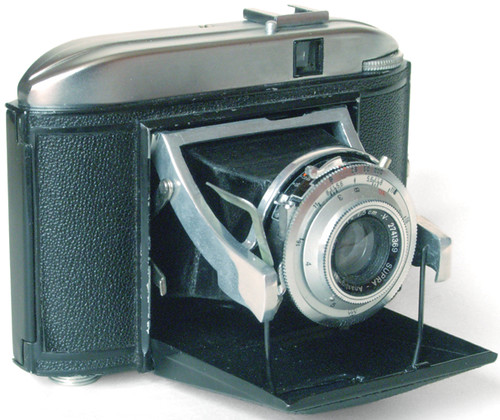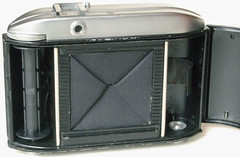Difference between revisions of "Nixette"
(more description) |
(=trixette; early vn had body release) |
||
| Line 7: | Line 7: | ||
}} | }} | ||
| − | The '''Nixette''' is a 6x6cm [[folding]] camera made by [[Nixon]] in Germany, c. | + | The '''Nixette''' (also badged as '''Trixette''') is a 6x6cm [[folding]] camera made by [[Nixon]] in Germany, c.1954. The body is based on a metal casting, with a thin sheet metal pressing for the bed. Early versions have a body release; later (Trixette II) versions have the shutter release operated by a long lever, coming up from the side of the lens barrel, and bending back over the strut. |
* Shutter: [[Vario]] 25,50,200 + B | * Shutter: [[Vario]] 25,50,200 + B | ||
* Lens: Supra Anastigmat, 75mm/f5.6, focus down to 3ft, stopping to f16. | * Lens: Supra Anastigmat, 75mm/f5.6, focus down to 3ft, stopping to f16. | ||
| Line 18: | Line 18: | ||
|image_text= Inside the Nixette, showing folded bellows | |image_text= Inside the Nixette, showing folded bellows | ||
}} | }} | ||
| − | The Nixette has an unusual folding action. | + | The Nixette has an unusual folding action. In early models the struts are metal stampings, in later models (illustrated) the struts and the curved member across the top of the lens block are one solid alloy casting<ref>{{McKeown}} 12th ed. pp.342-343</ref>; the [[bellows]] fold across the diagonals of the sides. To fold, a catch (seen beside the bellows in the photo above) is pressed and then the struts are pressed downwards; this forces the bed downwards. The lens folds down, and then the bed can start to close. |
The opening catch is operated by a small button on the top plate, beside the accessory shoe - the bed opens with a strongly sprung action. | The opening catch is operated by a small button on the top plate, beside the accessory shoe - the bed opens with a strongly sprung action. | ||
{{br}} | {{br}} | ||
| + | <references /> | ||
=== Links === | === Links === | ||
| + | * [http://rick_oleson.tripod.com/index-96.html Rick Oleson's collection includes a Trixette] | ||
[[Category: N]] | [[Category: N]] | ||
[[Category: Folding]] | [[Category: Folding]] | ||
[[Category: 120 film]] | [[Category: 120 film]] | ||
Revision as of 19:19, 30 June 2008

|
| Nixette |
The Nixette (also badged as Trixette) is a 6x6cm folding camera made by Nixon in Germany, c.1954. The body is based on a metal casting, with a thin sheet metal pressing for the bed. Early versions have a body release; later (Trixette II) versions have the shutter release operated by a long lever, coming up from the side of the lens barrel, and bending back over the strut.
- Shutter: Vario 25,50,200 + B
- Lens: Supra Anastigmat, 75mm/f5.6, focus down to 3ft, stopping to f16.
- Film: 120, twelve 6x6cm images

|
| Inside the Nixette, showing folded bellows |
The Nixette has an unusual folding action. In early models the struts are metal stampings, in later models (illustrated) the struts and the curved member across the top of the lens block are one solid alloy casting[1]; the bellows fold across the diagonals of the sides. To fold, a catch (seen beside the bellows in the photo above) is pressed and then the struts are pressed downwards; this forces the bed downwards. The lens folds down, and then the bed can start to close.
The opening catch is operated by a small button on the top plate, beside the accessory shoe - the bed opens with a strongly sprung action.